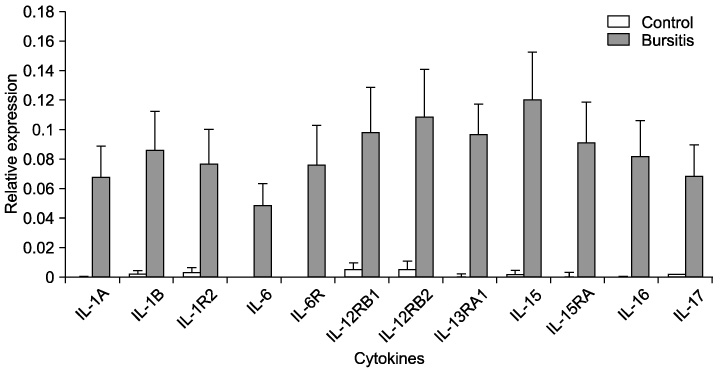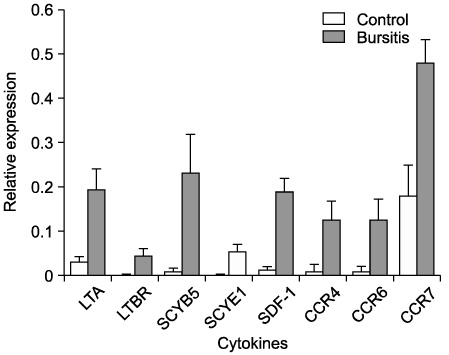J Korean Orthop Assoc.
2008 Apr;43(2):171-180. 10.4055/jkoa.2008.43.2.171.
Gene Expression Profile Analysis by cDNA Array in the Subacromial Bursa of Patients with Rotator Cuff Disease
- Affiliations
-
- 1Department of Orthopedic Surgery, Kangnam St. Mary's Hospital, The Catholic University of Korea College of Medicine, Seoul, Korea. osjmk@korea.com
- 2Center for Shoulder, Elbow and Sports Medicine, Columbia University College of Physicians and Surgeons, New York, USA.
- KMID: 2106436
- DOI: http://doi.org/10.4055/jkoa.2008.43.2.171
Abstract
-
PURPOSE: To examine the expression pattern of inflammatory cytokines/receptors in the subacromial bursa of patients with rotator cuff disease using a cDNA(Complement DNA) Array technique.
MATERIALS AND METHODS
Twenty two human subacromial bursal specimens were obtained intraoperatively from patients during shoulder surgery (18 bursitis, 4 normal bursa). The RNA was isolated from the bursal tissues and the presence of gene expression was analyzed using a cDNA Array technique. The statistical differences between bursitis and the normal bursa specimens were determined using a Mann Whitney U test and Student's t-test.
RESULTS
cDNA Array analysis revealed a significant increase in the expression of several cytokine genes and their receptors in patients with subacromial bursitis compared with the controls (p<0.05). These cytokines included the interleukins (IL-1, 6, 12, 13, 15, 16, 17) and their receptors, lymphotoxin, small inducible cytokines, chemokine receptor (CCR 4, 6, 7) and stromal cell derived factor-1 (SDF-1).
CONCLUSION
This study demonstrated a significant increase in many inflammatory cytokines in the subacromial bursa of patients with rotator cuff disease. This suggests that there is an active inflammatory reaction at the subacromial bursa in rotator cuff disease.
Keyword
MeSH Terms
Figure
Reference
-
1. Agyekum S, Church A, Sohail M, et al. Expression of lymphotoxin-beta (LT-beta) in chronic inflammatory conditions. J Pathol. 2003. 199:115–121.2. Baggiolini M. Chemokines in pathology and medicine. J Intern Med. 2001. 250:91–104.
Article3. Berger AC, Tang G, Alexander HR, Libutti SK. Endothelial monocyte-activating polypeptide II, a tumor-derived cytokine that plays an important role in inflammation, apoptosis, and angiogenesis. J Immunother. 2000. 23:519–527.
Article4. Bleul CC, Fuhlbrigge RC, Casasnovas JM, Aiuti A, Springer TA. A highly efficacious lymphocyte chemoattractant, stromal cell-derived factor 1 (SDF-1). J Exp Med. 1996. 184:1101–1109.
Article5. Bradfield PF, Amft N, Vernon-Wilson E, et al. Rheumatoid fibroblast-like synoviocytes overexpress the chemokine stromal cell-derived factor 1 (CXCL12), which supports distinct patterns and rates of CD4+ and CD8+ T cell migration within synovial tissue. Arthritis Rheum. 2003. 48:2472–2482.
Article6. Chin RK, Lo JC, Kim O, et al. Lymphotoxin pathway directs thymic Aire expression. Nat Immunol. 2003. 4:1121–1127.
Article7. Fu YX, Chaplin DD. Development and maturation of secondary lymphoid tissue. Annu Rev Immunol. 1999. 17:399–433.8. Gotoh M, Hamada K, Yamakawa H, Inoue A, Fukuda H. Increased substance P in subacromial bursa and shoulder pain in rotator cuff diseases. J Orthop Res. 1998. 16:618–621.
Article9. Gotoh M, Hamada K, Yamakawa H, et al. Interleukin-1-induced subacromial synovitis and shoulder pain in rotator cuff diseases. Rheumatology (Oxford). 2001. 40:995–1001.
Article10. Hitchon C, Wong K, Ma G, Reed J, Lyttle D, El-Gabalawy H. Hypoxia-induced production of stromal cell-derived factor 1 (CXCL12) and vascular endothelial growth factor by synovial fibroblasts. Arthritis Rheum. 2002. 46:2587–2597.
Article11. Kanbe K, Takemura T, Takeuchi K, Chen Q, Takagishi K, Inoue K. Synovectomy reduces stromal-cell-derived factor-1 (SDF-1) which is involved in the destruction of cartilage in osteoarthritis and rheumatoid arthritis. J Bone Joint Surg Br. 2004. 86:296–300.
Article12. Kane MD, Jatkoe TA, Stumpf CR, Lu J, Thomas JD, Madore SJ. Assessment of the sensitivity and specificity of oligonucleotide (50mer) microarrays. Nucleic Acids Res. 2000. 28:4552–4557.
Article13. Kao J, Houck K, Fan Y, et al. Characterization of a novel tumor-derived cytokine. Endothelial-monocyte activating polypeptide II. J Biol Chem. 1994. 269:25106–25119.
Article14. Kao J, Ryan J, Brett G, et al. Endothelial monocyte-activating polypeptide II. A novel tumor-derived polypeptide that activates host-response mechanisms. J Biol Chem. 1992. 267:20239–20247.
Article15. King HC, Sinha AA. Gene expression profile analysis by DNA microarrays: promise and pitfalls. JAMA. 2001. 286:2280–2288.16. McInnes IB, al-Mughales J, Field M, et al. The role of interleukin-15 in T-cell migration and activation in rheumatoid arthritis. Nat Med. 1996. 2:175–182.
Article17. Minty A, Chalon P, Derocq JM, et al. Interleukin-13 is a new human lymphokine regulating inflammatory and immune responses. Nature. 1993. 362:248–250.18. Nanki T, Hayashida K, El-Gabalawy HS, et al. Stromal cell-derived factor-1-CXC chemokine receptor 4 interactions play a central role in CD4+ T cell accumulation in rheumatoid arthritis synovium. J Immunol. 2000. 165:6590–6598.19. Neer CS 2nd. Impingement lesions. Clin Orthop Relat Res. 1983. 173:70–77.
Article20. Pablos JL, Santiago B, Galindo M, et al. Synoviocyte-derived CXCL12 is displayed on endothelium and induces angiogenesis in rheumatoid arthritis. J Immunol. 2003. 170:2147–2152.
Article21. Power CA, Furness RB, Brawand C, Wells TN. Cloning of a full-length cDNA encoding the neutrophil-activating peptide ENA-78 from human platelets. Gene. 1994. 151:333–334.
Article22. Rowe CR. Rowe CR, editor. Tendinitis, bursitis impingement, snapping scapula, and calcific tendinitis. The shoulder. 1988. 1st ed. New York: Churchill Livingstone;105–129.23. Sakai H, Fujita K, Sakai Y, Mizuno K. Immunolocalization of cytokines and growth factors in subacromial bursa of rotator cuff tear patients. Kobe J Med Sci. 2001. 47:25–34.24. Santavirta S, Konttinen YT, Antti-Poika I, Nordström D. Inflammation of the subacromial bursa in chronic shoulder pain. Arch Orthop Trauma Surg. 1992. 111:336–340.
Article25. Sarkar K, Uhthoff HK. Ultrastructure of the subacromial bursa in painful shoulder syndromes. Virchows Arch A Pathol Anat Histopathol. 1983. 400:107–117.
Article26. Schmouder RL, Streiter RM, Walz A, Kunkel SL. Epithelial-derived neutrophil-activating factor-78 production in human renal tubule epithelial cells and in renal allograft rejection. Transplantation. 1995. 59:118–124.
Article27. Soifer TB, Levy HJ, Soifer FM, Kleinbart F, Vigorita V, Bryk E. Neurohistology of the subacromial space. Arthroscopy. 1996. 12:182–186.
Article28. Szomor ZL, Wang MX, Kruller A, et al. Differential expression of cytokines and nitric oxide synthase isoforms in human rotator cuff bursae. Ann Rheum Dis. 2001. 60:431–432.
Article29. Taga T, Kishimoto T. Gp 130 and the interleukin-6 family of cytokines. Annu Rev Immunol. 1997. 15:797–819.30. Taniguchi M, Miura K, Iwao H, Yamanaka S. Quantitative assessment of DNA microarrays-comparison with Northern blot analyses. Genomics. 2001. 71:34–39.
Article31. Watanabe N, Ando K, Yoshida S, et al. Gene expression profile analysis of rheumatoid synovial fibroblast cultures revealing the overexpression of genes responsible for tumor-like growth of rheumatoid synovium. Biochem Biophys Res Commun. 2002. 294:1121–1129.
Article32. Yanagisawa K, Hamada K, Gotoh M, et al. Vascular endothelial growth factor (VEGF) expression in the subacromial bursa is increased in patients with impingement syndrome. J Orthop Res. 2001. 19:448–455.
Article
- Full Text Links
- Actions
-
Cited
- CITED
-
- Close
- Share
- Similar articles
-
- Tophaceous Gout in the Rotator Cuff with Impingement Syndrome: A Case Report
- Fluid Signal Intensity That Mimicked A Supraspinatus Tendon Tear In A Subacromial Injected Shoulder: A Case Report
- Can the Rotator Cuff Tear Be Treated with Atelocollagen?
- Inflammatory Cytokine Expressions of the Subacromial Bursitis and Glenohumeral Joint Synovitis in the Patients with Full Thickness Rotator Cuff Tear
- The Study of Sodium-Hyaluronate to the Expression of MMP-2 during Healing Process of the Acute Rotator Cuff Tear in Rats




